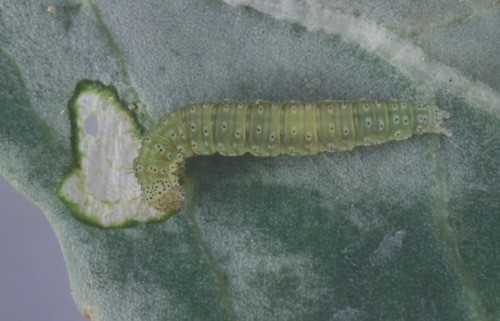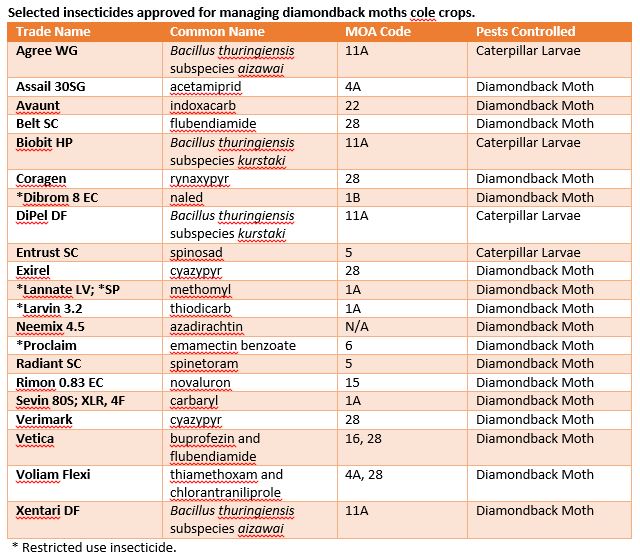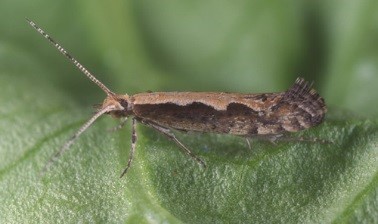Matt Lollar, Jackson County Horticulture Agent
Diamondback moths were recently discovered in a greenhouse crop of arugula in Jackson County, and they may soon be moving to a field near you. Diamondback moths can be detrimental to cole crops. Adults are approximately ¼ inch long, skinny, and have long antennae. They have a tan to light brown band along their backs. The band is often serrated, which creates the “diamondback” pattern. The moths are poor fliers, but are easily carried long distances by the wind. Pupa develop in loose silk cocoons on the outer leaves of most crops and sometimes in the florets of broccoli and cauliflower.
Feeding damage is caused by the larval stage. Larvae can have a length of a tenth of an inch to nearly half an inch, depending on age. They are green in color and have five pairs of stubby, false legs called prolegs. The larvae feed on the lower surface of the leaf where their chewing produces irregular patches. The upper surface of the leaf is often left intact.
Diamondback moths have been recorded in all US states where cabbage is grown. In the panhandle their presence is magnified and they can produce 8 to 12 generations a year. The moths only attack plants in the Brassicaceae family including broccoli, Brussels sprouts, cabbage, cauliflower, collard, kale, kohlrabi, mustard, radish, turnip, and watercress. Crop species are not equally preferred. For example, diamondback moths prefer to lay their eggs in collard plants as opposed to cabbage.

Larva of the diamondback moth, Plutella xylostella (Linnaeus). Note the feeding damage scar. Credit: Lyle Buss, University of Florida
A well-developed Integrated Pest Management (IPM) program is necessary to control diamondback moths. This requires combining various strategies such as biological, cultural, and chemical controls.
- Biological Control – Various natural enemies such as the wasps Microplitis plutellae, Diadegma insulare, and Diadromus subtilicornis are known to be parasitoids of diamondback moths. Various fungi and viruses may occur if population densities are high.
- Cultural Control – Young larvae can be killed by heavy rainfall. This can be mimicked by overhead irrigation, however extended periods of leaf wetness will also promote disease. It is important to note that eggs are often laid on alternate host species. Alternate hosts are weed species in the Brassicaceae family such as wild radish, wild mustard, bittercress, and pepperweed.
- Chemical Control – A number of insecticides are labeled for diamondback moth control. It is important to rotate insecticide Mode of Action (MOA) to avoid developing resistance. More information on resistance management and rotation can be found at Resistance Management for Sustainable Agriculture and Improved Public Health.
 Labels change frequently. Be sure to read a current product label before applying any chemical. Please visit the Vegetable Production Handbook for a complete pest control guide for cole crops. For more information on diamondback moths please visit the EDIS Publication: Diamondback Moth, Plutella xylostella (Linnaeus) (Insecta: Lepidoptera: Plutellidae) or UC IPM Diamomdback Moths.
Labels change frequently. Be sure to read a current product label before applying any chemical. Please visit the Vegetable Production Handbook for a complete pest control guide for cole crops. For more information on diamondback moths please visit the EDIS Publication: Diamondback Moth, Plutella xylostella (Linnaeus) (Insecta: Lepidoptera: Plutellidae) or UC IPM Diamomdback Moths.
- Crops to Consider for Fall Planting - September 26, 2025
- Benefits of Manure Fertilizers and Analysis - March 21, 2025
- Mushrooms – A Crop Worth Consideration for the Back Forty - October 4, 2024

